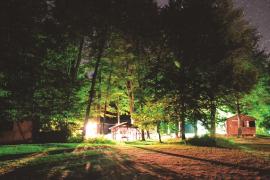Camp cabins haven’t changed much in the past 50 years. Typical camp cabins are stick-frame buildings with wooden floors, screened windows, bunk beds, and little else. They may or may not include air conditioning, plumbing, or electrical outlets. While these cabins are nostalgic, they are often missing some of the benefits of modern cabin designs, including easy assembly, energy efficiency, and environmentally friendly materials.
High lumber prices are also making primitive stick-frame cabins cost-prohibitive for many camps (Kral, 2022). As a result, modular cabins built with structural insulated panels (SIPs) have arisen as a cost-effective, environmentally friendly, energy-efficient alternative to stick-frame cabins.
What Are Structural Insulated Panels?
SIPs are constructed as a sandwich of oriented strand board (OSB) and encapsulated polystyrene foam (EPS). OSB is a green building material that relies on a fast-growing, underutilized, and often less-expensive wood species that is ground into chips and then converted into board.
SIPs do not contain any volatile organic compounds (VOCs) or other harmful chemicals and meet some of the most stringent standards for indoor air quality. Building a cabin with SIPs requires less energy to heat and cool than traditional stick frame cabins. SIPs are one of the most airtight, green, and well-insulated building systems available. As a result, SIPs create a tightly insulated structure for energy efficiency and strength.
Below are some questions and tips to help you get started planning and designing environmentally friendly, energy-efficient modular camp cabins made of SIPs.
How Many Campers Do You Want to House?
While summer camps saw a sharp decline in 2020, they are quickly rebounding and expected to grow by 11.1 percent in 2022 (IBISWorld, 2021). This is due to a pent-up demand of consumer spending on recreation. Plus parents desire to have their kids develop independence and enjoy positive social and community experiences. Demand is there and will continue to grow as communities emerge from the pandemic. Tom Rosenberg, president and CEO of the American Camp Association, said in a Washingtonian article that “early enrollment ‘skyrocketed’ last fall, with interest both from families who send kids every year and from those new to camp” (Dalphonse, 2022).
More campers means the need for more cabins and a chance to reimagine older cabins that require renovation. You will have to do some math to determine how many cabins you need based on the number of campers you want to house and expected growth. Stand-up height lofts can be added to increase the number of campers per cabin or to create additional space for counselors or extra storage.
Also consider the impact of additional campers on other camp operations beyond cabin space. Alyson Gondek, executive director of Camp Woodmont, offers these tips: “When thinking of building a new cabin, a challenge is determining if you have enough bathrooms for more campers, and, if not, if you have the plumbing necessary (septic tanks) to build additional bathrooms. You also have to consider if your camp’s dining hall has enough room for more tables, chairs, benches, etc., and if the kitchen has the capacity to cook more food for the additional mouths to feed.”
How Will the Cabins Be Used?
Do you want primitive cabins that provide an escape from modern life, or do you want cabins equipped with electricity and modern conveniences? Do you plan to have a bathroom in each cabin, or will there be a central kitchen and bath house? Do you want the cabins to fit in with the landscape, or do you want them to stand out with fun, colorful designs?
Also consider how cabin design will support your programming. Many camps are only open during the hot summer months; however, adding cabins built with SIPs may allow you to offer year-round camp programs. The insulation value of SIPs protects against both hot and cold temperatures. The thickness of the structural insulated panels determines the R-value of the building (Energy Saver, n.d.). Because very little air infiltration occurs through SIPs, it is easy to achieve an energy-efficient building. If cabins are sealed up during the off-season, an added bonus of SIPs is that the buildings’ airtight structure is a deterrent for many would-be critters and pests.
How Will You Heat and Cool the Cabins?
Several options for HVAC systems are typical for SIP cabin applications. Mini-split heat pumps are common and provide the ability to place the unit just about anywhere within the structure with only a small penetration for the line to the external unit. Packaged terminal heat pumps (PTAC heat pumps) are single-unit heat pumps similar to the inside portion of the mini-split, although they generally require a larger opening in the wall.
It is also possible to install a standard window AC unit and a separate heat source. Remember, the thermal efficiency of an SIP structure means that you will not need a lot of heating or cooling energy to maintain a comfortable environment.
If you have a large number of cabins in a remote area, it may be worth the investment to install geothermal cooling and heating for an off-grid solution (Reynolds, 2021). All SIP structures are extremely airtight, so proper air circulation is important — especially if you include a bathroom and a kitchen. The addition of an energy recovery ventilation (ERV) system will maintain the air quality and keep energy use low.
How Will You Construct the Cabins?
While you could hire a contractor to build SIP cabins, two to three workers can assemble a cabin structure in a matter of days. Building an SIP cabin is accomplished in three phases:
- Installing the foundation or slab
- Assembling the kit
- Finishing the exterior and interior
Zoning regulations may require that you place SIP cabins on a particular type of foundation. Water, electricity, and sewer should be provided at the site prior to the installation of SIP cabins. Grouping SIP cabins together to share utilities — such as plumbing, septic, and electricity — reduces operating costs.
SIP cabin flat pack kits often contain most of the materials you need to construct your tiny house, including splines, precut lumber, fasteners, caulk, and foam sealants. Additional materials, such as doors, windows, and finishing materials are usually purchased separately. SIPs panels are joined with splines and nails, then glued with injected foam. This seals the panel joints and creates an envelope with no openings, except for the window and doors. SIPs are already insulated, so no need to install insulation.
One of the challenges of building camp cabins is delivering materials to remote areas, according to Jeff Carter, director and owner of Rockbrook Camp. “Like many camps, most of our cabins are placed in the woods and are not near roads,” said Carter. The lightweight nature of SIPs makes it possible to deliver complete kits to camp grounds, including remote sites.
What Do Campers and Their Parents Value?
A final thing to consider is what your campers (and their parents) value. While Generation Alpha, born after 2010, is still young, some key characteristics are becoming obvious (Annie E. Casey Foundation, 2020). Today’s young campers are looking for unique experiences, and they value personalization and individuality. Cabins with unique features, such as colorful decor, mascots, lanterns, wall art, and unique names and themes for each cabin make each camper’s experience memorable.
Modernizing camp cabin design with environmentally friendly, energy-efficient materials also connects with the values of today’s generation of campers and their parents. According to the NC State University article “Meet the Mini Millennials: Generation Alpha” (Dretsch, 2021):
As health-conscious caretakers, millennial parents seek out a lot of information about the products they buy and expose their kids to. From toys and food to clothing and personal care products, they love to be in the know about the best brands for their children, and they choose only the safest, cleanest, highest-quality ones. And because they’re calling the shots about which products enter the home, they’re also controlling which brands Gen Alpha is exposed to from a young age. In that sense, Gen Alpha will develop very similar preferences as their millennial gatekeepers — because it’s all they know.
References
- Annie E. Casey Foundation. (2020, November 4). What is Generation Alpha? aecf.org/blog/what-is-generation-alpha
- Dalphonse, S. (2022, February 17). Summer camp demand is skyrocketing — despite (or maybe because of) Covid. Washingtonian. washingtonian.com/2022/02/17/summer-camp-demand-is-skyrocketing-despite-or-maybe-because-of-covid/
- Dretsch, H. (2021, October 1). Meet the mini millennials: Generation Alpha. Poole Thought Leadership, NC State University. poole.ncsu.edu/thought-leadership/article/meet-the-mini-millennials-generation-alpha/
- Energy Saver. (n.d.). Insulation. energy.gov/energysaver/insulation
- IBISWorld. (2021, December 29). Summer camps in the US. ibisworld.com/industry-statistics/market-size/summer-camps-united-states/
- Kral, H. (2022, March 17). Why lumber prices are soaring again in 2022. Family Handyman. familyhandyman.com/article/why-lumber-prices-are-soaring-again-in-2022/
- Reynolds, M. (2021, July 28). Geothermal heating for homes in North America — does it work & will it save money? Ecohome. ecohome.net/guides/2349/geothermal-heating-and-cooling/
Frank Golley holds degrees in industrial design from The Georgia Institute of Technology and North Carolina State University. He has designed IBM computers, Star Wars branded toys for Kenner, vending machines, and package designs for Coca-Cola USA, and has multiple patents. As broker/owner of Golley Realty Group LLC, he has spent more than 20 years flipping houses and selling homes. Golley created Golley Houses to address the affordable housing crisis, including helping people create additional space at a reasonable cost. The Golley House has been designed using efficient manufacturing methods and modularity to create a simple-to-assemble structure that can be customized for a range of uses. For more information visit golleyhouses.com.
Photo courtesy of Golley Houses, Decature, GA.



